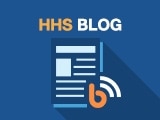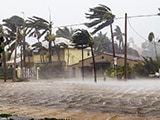How We Transformed Public Health Data for COVID-19 and the Future
Data is the lifeblood of good public policy, of successful public health efforts, and of any effective emergency response. Especially during an unprecedented emergency like COVID-19, tackling the public health challenges we confront at the Department of Health and Human Services (HHS) requires accurate data, in as close to real time as possible. Over the past year, HHS has completely transformed how it collects, aggregates, and analyzes data for a challenge like COVID-19. These efforts will have a lasting effect on how our country deals with public health data, leaving us better prepared for future outbreaks and other health challenges.
One of the key elements of a response to a health emergency like a pandemic is knowing the burden on healthcare systems—especially the capacity hospitals have for treating patients. But, before the COVID-19 pandemic, the federal government simply did not have a way to know how many patients with a given virus are in hospitals across America.
Moreover, there were many other data points that decision-makers, responders, and analysts across the federal government and state governments would benefit from having access to: levels of crucial supplies, case counts, death rates, demographic information about patients, health expenditure data, and more. These data come from many different sources: federal agencies, state governments, hospitals, other health providers, laboratories, and more. Different federal agencies collect data in different ways, sometimes from sources that conflict.
So, at the end of March, the White House Task Force and leaders at HHS realized that we needed a single data hub: a place where all this data could be securely gathered and accessed by those who needed it. That was the genesis of HHS Protect, an unprecedented system and set of capabilities, powered by various private sector technologies, for sharing, parsing, housing, and accessing COVID-19 data. It was constructed in less than 10 days by dedicated public servants in the HHS Office of the Chief Information Officer and an integrated, cross-agency COVID-19 federal response team, with partners across the federal government.
Putting all this data in one place was an incredible achievement. But just as important was ensuring we had the data we needed feeding into HHS Protect—like hospital capacity data.
The federal government previously did have some ways to track what’s going on in hospitals. From 2006 to 2016, HHS’s Office of the Assistant Secretary for Preparedness and Response (ASPR) ran a program called HAvBED. HAvBED requested hospitals that were members of ASPR’s Hospital Preparedness Program to provide their bed capacity on an annual basis and, upon ASPR’s request, to provide an update on how many beds were empty and available in the event of a disaster. This was a limited capability, however, only suitable for certain short-term emergencies. ASPR discontinued the program in 2016 because it imposed a burden on top of capacity metrics hospitals were tracking without providing much value to the federal government. In 2019, ASPR put out a standing opportunity for companies to propose new technologies and products that could help with these data challenges.
The Centers for Disease Control and Prevention (CDC) has a program called the National Healthcare Safety Network (NHSN), through which hospitals report data on healthcare-associated infections, as part of our work to understand and combat antimicrobial resistance. Hospitals are required to report infection data under Medicare regulations, but before the pandemic, NHSN did not capture data on capacity, occupancy, supplies, staffing, or other patient-specific measures.
As COVID-19 spread in the United States in March, it became clear that there was a real risk that hospitals in certain areas could become overwhelmed. We needed data about where COVID-19 patients were filling hospitals in order to understand how to allocate resources like PPE and federal healthcare personnel and to understand the spread of the virus by geography and patient age.
Multiple options were created to start capturing information from hospitals. CDC added the ability for hospitals to report into NHSN how many COVID-19 patients they had. Over the next few months, approximately 3,000 hospitals were eventually reporting this information into NHSN. Second, through the ASPR funding opportunity, we granted a contract to a company called Teletracking, which many hospitals use to report data to states and for other needs, so hospitals could begin reporting their number of COVID-19 patients that way. Hospitals were also using this system to report COVID-19 patient burden in order to demonstrate eligibility for HHS’s $175 billion provider relief fund. Because many states were requiring hospitals to report the same information being requested by the federal response, we also created a third option, to allow states to report on behalf of their hospitals.
Regardless of which of the three methods a hospital used, all of the data was consolidated into a unified hospital data set in HHS Protect. These data streams provided valuable visibility into needs across the country, and the data from them was widely available to federal responders and state decision-makers because of HHS Protect.
But, while many hospitals reported some data, the reporting was inconsistent and incomplete. We also needed data to be reported every day in order to have an actionable picture of stresses on hospitals across the country. When FEMA and HHS were working to efficiently route personal protective equipment to the places it was most needed, we needed granular data. This was a new need: For well-known diseases that have a long history, and especially before technology made near real-time reporting a realistic possibility, it was typical to rely on estimated data. But for a novel pandemic like COVID-19, where we are constantly monitoring new trends, we needed consistent reporting of actual data, not estimates, and the technology to do that existed.
Then, in the summer, another need arose: We had been shipping supplies of the one FDA-authorized treatment for COVID-19, remdesivir, through state health departments to hospitals, based on the data we had on hospital burden, because remdesivir is only for hospitalized patients. But when the science became clear that remdesivir was most effective early on in a hospital admission, we needed more granular data, and we needed to understand the inventory of remdesivir that hospitals had on hand.
Adding that kind of specific data field to CDC’s NHSN was going to take several weeks. Through Teletracking, it could be added in less than three days. Therefore, to get the data we needed most rapidly, CDC recommended that we shift all hospital reporting into Teletracking.
At the time we made that change, on July 15, about two-thirds of hospitals were reporting through Teletracking each week (some directly to us, and some routing the data through their state health departments). Over the course of this year, we’ve worked with hospitals and states and added new incentives to raise that number significantly. By the end of April, 65 percent of hospitals were reporting at least some data, with about 20 percent of hospitals reporting all of the requested fields every day of the week. By the beginning of 2021, 99 percent of hospitals are reporting not only weekly, but seven days a week, and 97 percent are reporting every required field, seven days a week. Having near-real-time updates about the number of COVID-19 patients in every hospital in the country is an incredible result—leaps and bounds beyond where we were at the beginning of the pandemic.
The system we’ve created also offers an even more efficient pathway forward. While the primary goal of Teletracking and HHS Protect has been to increase reporting rates, there are also technology options to reduce the burden of hospitals having to manually report data each day. Around 70 percent of hospitals now have the ability to have patient data electronically submitted directly from their electronic health records or other information systems, and we now have pilot projects to automate the reporting of data on supplies like PPE as well.
All this data can inform not just decisions about allocating key therapeutics, but plenty of other decisions by the federal government and state and local governments. In addition to the hospital data, HHS Protect offers access to more than 200 other data sets, from private-sector sources, federal agencies like the Centers for Medicare & Medicaid Services, CDC, and the Health Resources and Services Administration, and from state partners.
HHS Protect is a solution to a problem that has stymied HHS and government agencies for a long time: how to bring together the huge amounts of data we already have in usable ways to generate useful and actionable insights. To some extent, this was made possible by the emergency we faced. One common barrier to aggregating data from different sources is that agencies can sometimes be protective of their own data and reluctant to go through the work of signing complex data use agreements. The pandemic broke down these barriers and reminded us that we’re all better off when we collaborate and make use, safely and securely, of all the data we have.
Protect makes these diverse data sources available not just across the federal government—to thousands of authorized and vetted users at HHS agencies alone—but for state, territorial, and tribal governments too, including state public health officials and COVID-19 support staff for governors.
Significant amounts of data from Protect is also now available to the public. If you’ve perused, for instance, Covidtracking.com or the New York Times tool for learning how full hospitals are in your area, you’re drawing on HHS Protect-aggregated data.
Executing on this mission required a dedicated data team. HHS and other federal partners created a new, unique interagency team—the Data Strategy and Execution Workgroup—to create and manage the common data and analysis for the federal COVID-19 response, with experts from 13 agencies and components across the federal government. The team has a unified quality assurance process to review and correct errors in data, and it created governance processes to ensure all stakeholders have the data they need. This kind of unified data strategy has been essential to our success and will be a best practice in responses going forward.
Having all this data in one place has boosted our response efforts in diverse ways. Through Teletracking and HHS Protect, hospitals now report regularly on their stocks of PPE. Some hospitals themselves didn’t even keep track of this kind of data before the pandemic, and having it easily at hand for multiple stakeholders can inform decisions to ship PPE by the federal government and the states. Through an effort called Project Greenlight, we specifically monitor PPE data for trouble spots. If, for instance, it looks like a hospital has just a day’s worth of PPE left or has a severe staffing shortage, we can get in touch with the state or the facility to understand whether that’s a data error or a real emergency shortage.
PPE and staffing data are just two elements of a tool created by ASPR, the Healthcare Resiliency Control Tower, which provides states with the data needed to understand the status of their healthcare systems all in one place. Drawing on data that’s been available in HHS Protect for some time, the dashboard offers a full range of data points about how hospitals and long-term-care facilities may be under stress: bed capacity, ICU capacity, drug availability, staffing levels, positive tests, and PPE stocks.
In the event there is a serious shortage of, say, PPE, we are then in a position to work with states and hospitals to ensure they can get what they need from commercial distributors—whose supply chains we also have visibility into through systems built for the next-generation Strategic National Stockpile—or, if necessary, from the revamped and refilled Strategic National Stockpile itself.
HHS Protect isn’t just about hospitals—far from it. For instance, the testing task force working under Admiral Giroir uses it to access all of the data relevant to testing all in one place: daily test results and all of the related information from every state, how many swabs and reagents states have, where private-sector testing supplies are headed, and more. States like Missouri are using HHS Protect as their state data dashboard, and teams working on the placement of Operation Warp Speed’s vaccine clinical trials used HHS Protect Data as well.
Together, all of these data efforts represent what ought to be the future of federal public health data work: where the federal government is not directly collecting data itself, but working as an aggregator of the oceans of data already being generated.
The days of building customized programs and modules to monitor discrete public health threats is coming to an end. In a world where healthcare providers are generating so much data on their own, we need to be streamlining and automating reporting. In a world where Big Data informs so much of what the private sector does, the public sector has to be making maximum use of the incredible data resources at our disposal and working with private-sector technologies to make the data more useful and available. That is exactly what HHS Protect does.
Running such a system requires financial commitments, leadership buy-in, and the dedication of many talented public servants, but it is an incredibly valuable investment. The better data capabilities we’ve developed over this past year have not just enhanced the efficiency of our response but actually saved lives. That is the goal of all public health efforts, and the future of data in supporting that work is now brighter than ever.
The Future of AI in Health and Human Services


